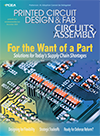Features Articles

We speak so often of the maturing (“graying”) of the engineers and operators who work in the printed circuit industry, we sometimes overlook whether the same term applies to the companies that employ those individuals.
And yet that matzah ball is hanging out there, particularly when it comes to printed circuit design software.
The textbook definition of a mature market is when it has reached a “state of equilibrium.” This is characterized by “an absence of significant growth or a lack of innovation.”
It goes on: “In a mature market, companies have excess inventory or capacity, products become more homogenized (less differentiated), and there is pressure on prices and profits.”
Can you think of anything in our corner of the world that applies to?
Bare board fabrication comes to mind. Even as the volume and frequency of electronics are exploding, growth at the manufacturing level is nominal, year in, year out. A relative handful of customers, such as Apple, Samsung and Intel, often dictate the winners and losers.
To continue reading, please log in or register using the link in the upper right corner of the page.

A near real-time feedback loop between layout and assembly.
Two core tenets of Lean manufacturing philosophy are eliminating defect opportunities and minimizing process variation. Consequently, most companies embracing Lean principles do some form of design for manufacturability (DfM) analysis to identify manufacturability issues either during design or in the new product introduction phase. In some cases, this is an automated feature of design software. In other cases, this is done manually.
SigmaTron has adopted a hybrid process that uses software automation to speed basic analysis, followed by an engineering review. This E-DFM software tool reduces the time it takes to create a detailed report from several days to a few hours and works with SigmaTron’s existing Valor software platform.
Automating the process improves efficiency, since the engineering team reviews the automatically generated reports and suggests solutions for accuracy instead of individually performing a full analysis themselves. They then can make suggestions to further optimize the recommendations, as needed. The tool has been customized from industry-standard PCBA design rules and SigmaTron’s equipment/process-specific manufacturing guidelines, so it reflects equipment and process constraints.
To continue reading, please log in or register using the link in the upper right corner of the page.

What’s more in need of rehabilitation? The bonepile, or supplier gateway?
Hello, I would like to get some information about your capabilities for Bonepile Rehabilitation. I have some legacy circuit cards that were previously tested on a FACTRON 750. Can you reverse engineer the schematics/gerbers from a known good board? Once you have diagnosis (sic) the problem on a failed board, can you also perform the repair? Are you cybersecurity certified for ITAR data?
This is how an unsolicited customer engagement often begins. No unusual requirements here, other than the obvious need for remedial grammar lessons.
“Yes, yes and yes.”
Good. Then you may be able to assist us. What is your process?
To continue reading, please log in or register using the link in the upper right corner of the page.

Excessive temperature or moisture may be to blame.
Open connections on area array packages can be difficult to spot, particularly if they are intermittent electrical failures like the examples in FIGURE 1. One or more open joints can occur between the package and solder sphere or at the PCB pad interface. Reflow soldering with either convection or vapor phase can cause packages to move and separate. This can be caused by warping of the package or in some cases minor popcorning due to moisture. Both faults can be simulated and recorded with video for reference.
To continue reading, please log in or register using the link in the upper right corner of the page.

From autos to airplanes, change is in the air.
2020 has been an unusual and challenging year, although many of us can be thankful for the resilience of high-tech industries. Indeed, activity has surged in some sectors, and generally the outlook is relatively buoyant.
In my other role as president of the EIPC (European Institute for the PCB Community), I moderated the Institute’s Technical Snapshot webinar last November, at which Dr. Shiuh-Kao Chiang of Prismark described how various sectors have fared. While 5G infrastructure rollouts slowed and handset shipments fell about 10%, the PC market has been buoyed by the increase in work-from-home, and certain consumer markets such as wearables and smart appliances have also done well. Overall, he noted a surprising robustness across the electronics, semiconductor and substrate markets.
The automotive sector has been among the hardest hit, along with conventional commercial aerospace. Rebuilding after the damage to sales caused by the pandemic is just one of the challenges facing vehicle manufacturers right now. They are also contending with the push toward higher levels of driving automation, mandatory smart systems such as autonomous emergency braking, and real-time V2X capabilities, which are expensive to develop. At the same time, governments are signaling their intentions to accelerate electrification, which will require all manufacturers to move their entire product ranges to hybrid-electric or pure battery-EV platforms. The UK government has brought its intended start date forward to 2030. There is no doubt about the urgency, although I am sure at least hybrid-EVs will prove a steppingstone to the kinds of vehicles we use in the future.
To continue reading, please log in or register using the link in the upper right corner of the page.

Now, just how many people can we move off the floor?
This past year was most unusual, distracting and challenging, and many of those distractions and challenges appear they will remain with us well into the first half of the year. As industry begins to focus on post-pandemic planning, however, much has been learned over the past year that can and is being applied to planning for the future.
Possibly the most significant thing learned is technology can – and does – work! A generation of manufacturing and technology leaders knew little of platforms such as Zoom, WebEx, etc. Through baptism by fire, we have become believers in virtual interaction, its effectiveness and value. Equally significant is the realization that for many business functions, including those in manufacturing, remote working – aka working from home – works and offers much more flexibility than the traditional structured workplace.
Manufacturers have by necessity reconfigured shop floors to accommodate social distancing, cleaning protocols, and all that has gone with the Covid pandemic. Adding space between production lines can accommodate social distancing. But while effective, it has proven costly. Splitting shifts is another tactic. Employees may be willing today to change schedules to keep a job; however, it is not ideal in the long term. Meanwhile, in the office environment social distancing is accomplished via interactive technology. Further, many claim the efficiency and flexibility from employees working remotely and communicating virtually has been significantly better than they imagined. The office environment success and flexibility from harnessing virtual communication technology has not gone unnoticed by the manufacturing manager.
To continue reading, please log in or register using the link in the upper right corner of the page.
Press Releases
- Critical Manufacturing Partners with Canonical to Expand Cloud-Native Deployment Options for Manufacturers
- Heller Industries Becomes the Latest Partner to Join THE SMT FUTURE EXPERIENCE
- AIM Solder Signs New Distributor in Vietnam
- Variosystems launches AI platform for secure and connected supply chain services


